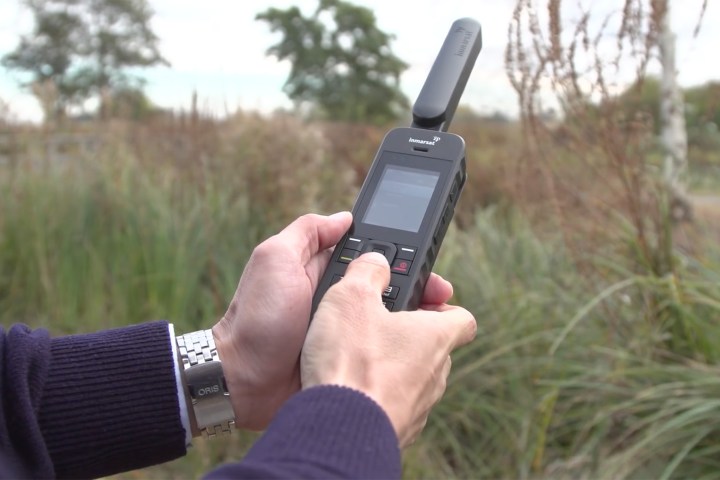

Satellite phones let you make and take calls in the field. Sat phones use one of four networks of satellites — only three of which serve the United States. Many models also send and receive text and email messages. Sat phones often include GPS and tracking functions, to use as a backup GPS or send SOS messages. Data connections come standard with most satellite phones, but don’t think you’ll use them to post photos on Instagram or browse the internet. Satellite phone data connections currently max out at 9.6 kbps.
The options from the various networks include marine, aviation, and automotive packages, special antennae, enhanced internet-quality connectivity devices (at equally-enhanced equipment and service costs), and more. We focused on the basic equipment.
Satellite phones and service plans aren’t cheap, although they’re less expensive today than they were 10 years ago. You’ll want to consider your needs and where you’ll be traveling carefully before buying or signing up for anything. The first step is to choose a network. Satellite network coverage, reliability, voice quality, and service costs vary widely. Once you’ve chosen a network (see below), you’ll then choose the phone and service plan which best fits your needs. To help you select the right phone, we’ve assembled a list of the five best satellite phones available from the three satellite networks that service the U.S. and beyond.
At a glance
| Product | Category |
| Iridium Extreme 9575 | The best satellite phone overall |
| Iridium Extreme 9575 PTT | The best global sat phone for teams who work in the toughest conditions |
| Iridium 9555 | The best bargain global sat phone for far-ranging travelers |
| IsatPhone 2 | The best sat phone for non-polar sailors and travelers, especially if you get wet a lot |
| Globalstar GSP-1700 | The best voice quality and lowest satellite and service price |
Iridium Extreme 9575
The best

Why you should buy this: True global functioning, ruggedness, integrated GPS and SOS button
Who it’s for: Frequent global travelers who need a phone that works anywhere, including the poles
How much it will cost: $1,157
Why we picked the Iridium Extreme 9575
You’ll soon see that three of the five phones on our list are Iridium models. Iridium is the only satellite network with truly global service — including the two poles. Iridium is also the only network that currently offers more than one phone, although earlier models still function on their respective networks. Iridium’s top-of-the-line Extreme 9575 sat phone is impressively rugged, and both dust- and water-resistant.
The 9575 has integrated GPS and an SOS button and lets you send and receive text messages and email, receive voicemail, and use it as a mobile hotspot. Maximum data speed is only 2.4 kbps, so short messages work best. If you need a rugged satellite phone to use absolutely everywhere, the Iridium Extreme 9575 is an easy choice. Talk time per battery charge is up to 4 hours.
Iridium Extreme 9575 PTT
The best global sat phone for teams who work in the toughest conditions

Why you should buy this: Global service, one-button radio messaging, extra rugged, longer battery life
Who it’s for: Teams that need dual function as a global sat phone and push-to-talk radio messaging
How much it will cost: $2230
Why we picked the Iridium Extreme 9575 PTT
Take everything great we said about the Iridium Extreme 9575, toughen it up even more, and add push-to-talk communications. This is the phone for working teams or groups that move around the area. In exchange for almost $300 more than the standard 9575, the PTT model is a true dual-purpose handheld communications tool. Fortunately, PTT minutes are free and don’t count against your satellite service plan.
The PTT’s larger battery powers just over six hours of talk time in phone mode and five hours in PTT mode. To enhance messaging in the field, the PTT button is extra rugged and the audio on this model is louder.
Iridium 9555
The best bargain global sat phone for far-ranging travelers

Why you should buy this: Global service, expedition quality without unnecessary ruggedness
Who it’s for: World travelers who don’t travel in extreme conditions
How much it will cost: $930
Why we picked the Iridium 9555
If global sat phone connectivity is a must but you really don’t need heavy duty ruggedness or backup GPS duty and an SOS button, the Iridium 9555 is your best choice. The 9555 boasts four hours of talk time and 30 hours standby. Like the Extreme 9575, the 9555 has SMS and email capability. The 9555’s ruggedness is all most people need for truly global travel and use.
Like the other Iridium phones, you can get a signal anywhere but if you have long calls — more than 15 minutes — the constant satellite movement may cause signal dropouts. You can talk while you walk with Iridium phones, which isn’t recommended with Inmarsat phones. All Iridium phones have the same service rates. The Iridium Monthly Wave Runner Plan, for example, provides 90 minutes a month for $100. Extra minutes cost $1.54 each.
IsatPhone 2
The best sat phone for non-polar sailors and travelers, especially if you get wet a lot

Why you should buy this: Strong acquired signal, splash resistance, mid-range price, integrated GPS and SOS button
Who it’s for: World travelers who stay within the 70th parallels, especially sailors
How much it will cost: $635
Why we picked the IsatPhone 2
The Inmarsat IsatPhone 2 doesn’t work at the north or south poles but as long as you’re staying within the 70th north and south parallels, it won’t matter much. Inmarsat has only three satellites compared to Iridium’s 66, all located over the equator, so you might have to move away from obstructions to get a good signal. Once you have a signal, Inmarsat reliability is better than Iridium’s because if you stand still the signal maintains its strength.
Reflecting its maritime heritage, the IsatPhone 2 is dust, shock, and splash resistant, and withstands 95 percent humidity. Battery life provides an impressive eight hours of talk time with 160 hours standby. The phone also has voicemail, SMS, and email messaging. A built-in GPS and emergency button sends a distress text to a pre-arranged number with your location. The IsatPhone 2’s price is lower than any of the Iridium phones but service plan costs are about the same. For example, Inmarsat’s IsatPhone Mid Plan costs $65 a month for 30 minutes, with extra minutes costing $1.05.
Globalstar GSP-1700
The best voice quality and lowest satellite and service price

Why you should buy this: Best voice quality, cell phone number assignment, low price
Who it’s for: Anyone who travels within Globalstar regional coverage zones and doesn’t need an extremely rugged phone
How much it will cost: $500
Why we picked the Globalstar GSP-1700
If you’re traveling or staying within one of the Globalstar regional coverage areas — much, but not all of the world — the Globalstar GSP-1700 is the bargain lover’s satellite phone. The network’s service rates, while still much more than cellular service, seem extremely reasonable compared to the others. The Globalstar Orbit 200 minute plan provides 200 minutes for $100, with extra minutes for $0.99 each. If you need any more than 200 minutes a month, the Globalstar Orbit Unlimited Plan is $150 for unlimited talk time, which seems like a wonderful deal by comparison.
Because Globalstar phones link with cell ground stations, they have far and away the clearest voice quality. With its 9.6 kbps data transfer speed, Globalstar is the speed demon of the lot but again that’s entirely relative. The GSP-1700 doesn’t send or receive SMS messages and there’s no GPS, but you can get your longitude and latitude directly from the phone while in talk mode. The Globalstar phone also has voicemail.
How the satellite networks differ
Iridium
Iridium‘s network is the market leader, with more than 500K subscribers. Iridium’s 66 LEO (low earth orbit) satellites — located 485 miles from Earth — are always moving. If you don’t have a signal when you first try, it shouldn’t take long on subsequent attempts. Furthermore, Iridium is the only satellite service which extends to the polar regions. Because the satellites are positioned all around the globe, you’ll have fewer connection problems with Iridium service in canyons or on the polar side of mountains than with Inmarsat’s satellites, which orbit in place above the equator.

Iridium phones allow you to talk and walk, which tends to be fairly problematic with Inmarsat. However, Iridium’s signal strength isn’t as consistent as Inmarsat signals because the satellites never stop moving. Calls longer than 15 minutes sometimes experience signal drops but if this happens, simply call again. Iridium phones do cost more and the service plans run roughly the same as Inmarsat — but less than Globalstar.
Inmarsat
The three Inmarsat GEO (geostationary) satellites circle the equator in relatively fixed orbits, 22,000 miles from earth. There’s no coverage in the polar regions but within the 70th north and south parallels, coverage is fine. Inmarsat signals tend to be hard to find if you’re on the polar side of a mountain, in a canyon, or behind a big building. In each of those cases, a straight line coming from the equator, even 22,000 miles high, won’t find you. So, you might need to move to get an Inmarsat signal.

When an Inmarsat signal is acquired, however, it’s reliable and won’t drop as long as you stand still. If Iridium satellites move to find phones, Inmarsat phones have to move to find satellites. Inmarsat originally established the network for the maritime industry, therefore they’re rugged and designed to be used in wet areas, although they are not waterproof. Inmarsat phones cost more than Globalstar devices but less than Iridium phones and its service cost is on par with Iridium.
Globalstar
Globalstar‘s 40 LEO (low earth orbit) satellites strangely don’t provide coverage across the entire globe, despite the company name. Globalstar sat phones are linked with 24 cellular ground stations and each phone features a localized regional phone number. This feature makes it easier for people to call Globalstar users but coverage does remain regionalized.

Globalstar has the best voice quality and lowest equipment and service prices. You cannot receive SMS text messages but there is voicemail service and the data transfer speed is the fastest of the three sat phone networks. At 9.6 kbps, Globalstar phones are four times as fast as phones on the Iridium and Inmarsat networks but are still very slow compared to smartphones or computers. If you live, work, or travel exclusively in areas with Globalstar coverage, this is the service to choose unless you need missing features offered by Iridium or Inmarsat.
Editors' Recommendations
- The 15 best GoPro accessories in 2024
- The best golf apps for iPhone and Android: 8 best ones in 2023
- The best action cameras
- The best cars for camping
- The best camper vans



